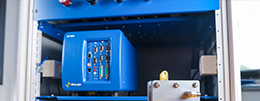AN 6. Advantages of the intermittent contact SECM : two examples in corrosion. Scanning Probe Electrochemistry.
Looking for something?
Results in
Products.
Accessories.
Document.
Advantages of the intermittent contact SECM : two examples in corrosion Scanning Probes – Application Note 6
Intermittent Contact (ic) SECM for relief of major topographic features Scanning Probes – Application Note 16
Scanning Probe Electrochemistry. AN 16. Application Note 16
Investigation of an interdigitated array electrode using ic-SECM Scanning Probes – Application Note 13
AN13. Investigation of an interdigitated array electrode using ic-SECM.. Scanning probe electrochemistry
The use of height tracking SECM to measure mechanically exfoliated graphite Scanning Probes – Application Note 17
AN17. Height tracking SECM to measure mechanically exfoliated graphite. Scanning Probe Electrochemistry
ac-SECM to investigate battery electrode materials in non-aqueous electrolyte Scanning Probes – Application Note 7
AN 7. ac-SECM to investigate battery electrode materials in non-aqueous electrolyte. Scanning Probe Electrochemistry.
dc- and ac-SECM Measurements on Si Nanowire Arrays Scanning Probes – Application Note 10
Application Note 10. AN 10. Scanning Probe Electrochemistry.
SECM height relief with OSP: an application in sensors Scanning Probes – Application Note 3
AN3. SECM height relief with OSP: an application in sensors. Scanning Probe Electrochemistry.
SECM height relief with OSP: An application in corrosion Scanning Probes – Application Note 2
AN2. SECM height relief with OSP: An application in corrosion. Scanning Probe Electrochemistry.
Using the SECM150 to Measure an NMC Battery Electrode Scanning Probes – Application Note 21
AN21. Measure an NMC Battery Electrode. Scanning probe electrochemistry
Ic-SECM – Bipolar Plates Scanning Probes – Application Note 23
Ic-SECM - Bipolar Plates - Scanning Probes - Application Note 23
Measurement of a nano-patterned gold sample by ic-/ac-SECM Scanning Probes – Application Note 11
AN11. Measurement of a nano-patterned gold sample by ic-/ac-SECM. Scanning Probe Electrochemistry.
Achieving micron scale measurements using the SECM150 Scanning Probes – Application Note 18
AN18. Achieving micron scale measurements. Scanning Probe Electrochemistry.
Use of ionic liquids in SECM experiments to distinguish effects of temperature and water in organic coating swelling
CITATION: D Trinh, C Vosgien-Lacombre, G Bouvet
Investigation of the diffusion of ferricyanide through porous membranes using the SECM150 Scanning Probes – Application Note 19
AN19. Investigation of the diffusion of ferricyanide through porous membranes using the SECM150. Scanning Probe Electrochemistry
Sweep scan with Height Tracking Scanning Probes – Application Note 26
The characterization of Vanadium Redox Battery Cells using BioLogic BCS-815 battery cyclers & a Pinflow® 20 cm² test cell.
Introducing the Microscopic Image Rapid Analysis (MIRA) software Scanning Probes – Application Note 5
AN5. Introducing the Microscopic Image Rapid Analysis (MIRA) software. Scanning Probe Electrochemistry.
Introduction to the USB-PIO: measuring the effect of light on a live leaf Scanning Probes – Application Note 15
AN 15. Application Note 15. Scanning Probe Electrochemistry
Introduction to the Modular Map Experiment: an Interdigitated Array electrode example Scanning Probes – Application Note 14
AN 14. Introduction to the Modular Map Experiment: an Interdigitated Array electrode example. Scanning Probe Electrochemistry.
Graphical and analysis tools in M370/M470 software Scanning Probes – Application Note 8
Application Note 8. AN 8. Scanning Probe Electrochemistry.
Introduction to Foil Cell Scanning Probes – Application Note 20
AN20. Introduction to Foil Cell. Scanning Probe Electrochemistry
3D Map production using the 3DIsoPlot softwareScanning Probes – Application Note 12
AN12. 3D Map production using the 3DIsoPlot software.Scanning probe electrochemistry.
Spatially confined electrochemical conversion of metal–organic frameworks into metal-sulfides and their in situ electrocatalytic investigation via scanning electrochemical microscopy
CITATION: Itamar Liberman, Wenhui He, Ran Shimoni, Raya Ifraemova and Idan Hod
Spatially confined electrochemical conversion of metal–organic frameworks into metal-sulfides and their in situ electrocatalytic investigation via scanning electrochemical microscopy
Authors: Itamar Liberman, Wenhui He, Ran Shimoni, Raya Ifraemova and Idan Hod
Intermittent Contact Alternating Current Scanning Electrochemical Microscopy: A Method for Mapping Conductivities in Solid Li Ion Conducting Electrolyte Samples
CITATION: Samantha Catarelli, Daniel Lonsdale, Lei Cheng, Jaroslaw Syzdek, Marca Doeff
Height tracking with the SKP370 or SKP470 module Scanning Probes – Application Note 1
AN 1. Height tracking with the SKP370 or SKP470 module. Scanning Probe Electrochemistry.
Mapping Electrochemical Heterogeneity at Iron Oxide Surfaces: A Local Electrochemical Impedance Study
CITATION: Marie Lucas and Jean-François Boily
Effect of physical ageing onto the water uptake in epoxy coatings
CITATION: Y Elkebir, S Mallarino, D Trinh, S Touzain
Learning center.
ac-, dc-, ic-, ic-ac, FB, GC… What does this SECM alphabet soup even mean?
A breakdown of the different techniques that make up SECM
SECM101: An Introduction to Scanning Electrochemical Microscopy
An introduction to Scanning Electrochemical Microscopy (SECM)
SECM101: What is Constant Distance (CD)-SECM?
Constant Distance (CD)-SECM is introduced in this BioLogic Learning Center article
ac-SECM101: An Introduction to Alternating Current-Scanning Electrochemical Microscopy
A short article outlining the principles and benefits of Alternating Current-Scanning Electrochemical Microscopy
ic-SECM101: An Introduction to Intermittent Contact-Scanning Electrochemical Microscopy
An overview of Intermittent Contact-Scanning Electrochemical Microscopy
SDC or SECM for high throughput scanning?
The article compares Scanning Electrochemical Microscopy (SECM) and Scanning Droplet Cell (SDC) for high throughput workstation
LEIS or ac-SECM?
Local Electrochemical Impedance Spectroscopy (LEIS) and Alternating Current-Scanning Electrochemical Microscopy (ac-SECM) are compared.
SECM101: Introduction to the redox mediator
The Scanning Electrochemical Microscopy (SECM) redox mediator is introduced.
SECM to form and screen micron scale electrocatalysts
Article illustrating how SECM can be used for high throughput screening of novel electrocatalytic materials destined for green energy sources
How to use SECM approach curves for energy applications
The Scanning Electrochemical Microscopy (SECM) Probe Approach Curve (PAC) is introduced. Its uses are shown with examples from energy storage and conversion.
dc-SECM and the SECM150
The dc-SECM technique. Includes a link to a more detailed, downloadable document.
What scanning probe electrochemistry platform is best for high throughput screening?
The article explains how to select the best high throughput workstation





